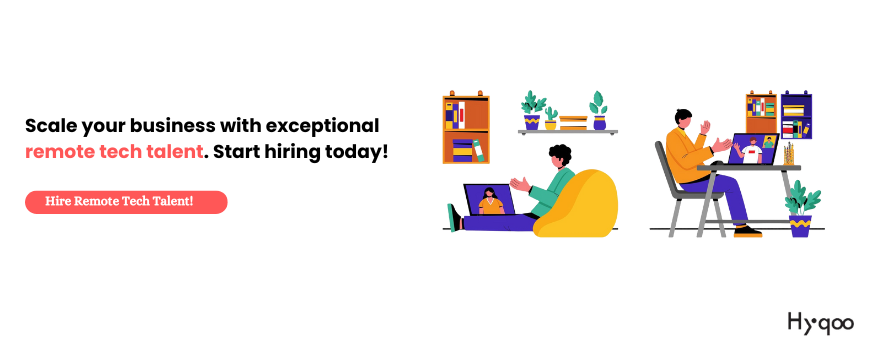9 Mins
9 Mins
Adapting to new trends is a necessity to keep ahead of the competitive curve because lagging behind is never an option. The COVID-19 outbreak opened several opportunities that boosted technologies and trends that were trying almost to look impossible or were trying to find their way to outshine.
The pandemic introduced a new way of continuing office operations through remote work. Since then, the companies have witnessed the advantages of this working model, like access to global remote talent, less operational expenses, and boosted productivity. A Statista Report published in 2023 states that around 83% of respondent employers believe that remote work is a success.
As per Flexjob’s Work Insights Survey, around 95% of working professionals prefer working either in a hybrid model or a full-time remote model. Besides, Rober Half’s Salary Guide says that 61% of employees are likely to apply for a job that offers remote work opportunities. Given the statistics, the trend of remote working is not going to dim down, instead, it will shine brighter than ever.
Remote hiring is on the rise, as according to the World Economic Forum, global digital jobs will increase by 25% to over 90 million jobs by 2030. Several key trends are expected to shape remote team hiring, communication, and talent management. Let’s look at the major hiring trends expected to improve remote work in 2025 and talent managers can utilize that to hire global remote talent and expand their workforce.
The transformative shift from on-site working to remote jobs will change the way forward-looking organizations will measure the performance of their employees. Now, the leaders can step back from taking a walk around the office and focus on the performance graphs of every team member meeting their respective goals, whether it is KPIs, MBOs or OKRs.
In the coming year, the organizations will be shifting to result-driven performance assessment, where employees will be assessed, trained, and managed on the basis of measurable results. This will help in improving the organizational outcomes and level the playing field of diverse talent.
It is doubtful that the issue related to “what’s the right workplace model” will get settled anytime soon. The leaders of the working class are somewhat divided between two notions: adopting the flexible working models and bringing back the traditional working model by resuming onsite work for all employees. For instance, Elon Musk, the CEO of Tesla and SpaceX, has proposed the potential of requiring the US federal workforce to work in-office full time.
However, some leaders, who think differently than leaders like Musk, will cheerily make use of this opportunity to hire talented employees who prefer flexibility in their jobs. Research over the past two years shows that Right-to-Office (RTO) mandates lead to brain drain. It drives out the high-quality talent, especially women, who are quite as ambitious as their male counterparts and high performers but require flexibility.
So, a number of leaders will hire their remote team by employing talented employees who are in senior positions in multinational companies, looking for opportunities that offer work-life balance and flexibility.
With the adoption of flexible working models, organizations have access to hire and build remote global teams. Now, the company gains the advantage of hiring talents beyond the geographical boundaries, but there are challenges that leaders are facing. For example, time zone differences make collaboration difficult for teams dispersed across different countries.
The role of leadership in remote work plays a crucial as leaders can setup strategic guidelines to streamline collaboration and communication. For the above challenge, leaders can set core hours where all the team members should be available to attend meetings.
Another major issue is the lack of focus time because employees are busy attending the meetings. Lack of focus during that time holds back the employees from giving their best. Again, policies like no-meeting days or no recurring meetings for more than two employees can help boost the employee’s productivity.
Employers tend to favor the hybrid model as compared to the complete remote working model. The hybrid model fits perfectly as it mixes in-office and remote work, offering the flexibility that employees require and allowing employers to streamline communication.
Companies that push RTO too hard may struggle to attract high-quality talent. Meanwhile, companies that go completely remote struggle to facilitate collaboration on complex projects. The hybrid model is the sweet spot that resolves the issue and helps companies find the right balance.
However, companies aiming for near-shore or off-shore hiring will benefit from a fully remote work model and strong leadership will play a significant role in streamlining the global team operations.
Traditional hiring methods consume a lot of time and have a higher hiring timespan, while remote hiring removes this drawback with a streamlined hiring process. Companies today use Artificial Intelligence (AI) and automation to streamline hiring processes. With the increased adoption of AI-driven hiring models, sourcing and initial screening of candidates has become much easier.
The rise of AI Talent Cloud makes it easier for talent managers to find the talent they are looking for to fill the vacant position within a week. The AI talent cloud finds a list of employees that matches the description, the talent managers can interview the potential candidates and hire the one that perfectly meets their expectations. Besides, AI algorithms can provide detailed insights about the interview through thematic analysis and automatic notes to help the employer perform manual analysis seamlessly.
Hyqoo’s AI Talent Cloud comes to help talent managers who are looking to hire and onboard highly skilled engineers and software developers, like full-stack developers. We are a global hiring solution partner and talent cloud platform to change the hiring landscape using innovative AI solutions.
Our Talent Cloud supports a network of over 14 million vetted professionals skilled in different tech stacks, like AI and ML, Data Science, Programming Languages, and Cloud Computing. Besides, our Talent Cloud’s capabilities are boosted by AI solutions which streamlines in finding the right match from our network. You can fill the form here describing the type of talent you are looking to hire, and we get back to you with highly aligned profiles and simplify the onboarding process.
Working in a remote setup depends on the companies and their goals, and there will be employees who are comfortable in either direction. However, with the flexibility we embraced during the pandemic, remote work should be ideal for many companies and their employees. With the benefits of working from home, companies should definitely consider remote work as a part of their policy.
While hiring remotely can be challenging, having the right tools and knowledge can help you streamline the entire process. Platforms such as Hyqoo can help you hire remote teams effectively and shorten the hiring timespan. Our mission is to reshape remote hiring with the help of Artificial Intelligence. By using our cutting-edge platform, you can get easy access to skilled professionals from anywhere around the world. Connect with us today to learn how you can revolutionize your global remote talent hiring with ease.
The main difficulties are communication, the development of team spirit, and protection from cyber threats for team members. It becomes the responsibility of a leader to adopt measures such as core working time to address the issue of cooperation and use technological methods to strengthen information sharing.
Eradicating data compromise is another aspect that requires organizations to implement sound security measures. These are the difficulties that companies must solve if they want to be fit for the remote work mode.
Managers don’t have to stick to a regular attendance-based system, as other parameters would prioritize results. It is better to use combined tools to track goal progress, such as OKRs and KPIs.
Training employees, giving them clear targets and objectives, and creating avenues for healthy and free-flowing communication also go a long way.
Furthermore, providing company guarantees, such as focus-time policies like no-meeting hours, allows employees to unplug from interruptions.
Indeed, remote work is likely to greatly increase workplace diversity. Remote work means that organizations have the opportunity to select talent regardless of geographical location, and location is no longer a limitation. Such an approach helps increase representation from different backgrounds, cultures, and experiences, nurturing innovation and inclusion.
Technology is indeed the backbone of remote work. Advanced tools like AI Talent Clouds streamline hiring processes by connecting companies with skilled professionals quickly.
Collaboration platforms like Slack and Zoom, along with project management tools such as Asana and Trello, promise seamless workflows.
AI-driven analytics provide actionable insights into employee performance, making remote management simple and efficient.
Employees should pay attention to several critical factors to develop effective remote work habits: schedule, communication, and tools. Another essential element is the constant renewal of competencies needed for remote work, including digital and self-organization skills. Members of virtual teams can engage in virtual social interactions and perform other team-building activities to foster a sense of belonging in the work environment.
Share Article
Subscribe and get fresh content delivered right to your inbox

15 Mins
In today’s fast-changing digital economy, leveraging AI and automation is no longer optional—it’s essential for sustained growth and innovation. This article explores proven strategies to integrate intelligent technologies across core business functions, from operations to customer experience. Learn how leading companies are using automation to boost productivity, reduce costs, and stay ahead of the competition. Whether you're scaling a startup or modernizing an enterprise, these insights will help you navigate the future of work with confidence. Read more now.
Continue Reading

13 Mins
Explore critical strategies to manage data privacy risks in remote work environments. This article covers practical solutions to safeguard sensitive information, secure communication channels, and ensure compliance with global data protection regulations. Whether you're leading a distributed team or working remotely yourself, you'll learn how to implement effective security measures, reduce vulnerabilities, and build a strong privacy-first culture. Stay ahead of emerging threats and protect your data with these proven remote work privacy best practices. Read the article now.
Continue Reading

13 Mins
Discover the key differences between Kanban and Agile methodologies to help you choose the right framework for your project's success. This article breaks down each approach, comparing workflows, team structure, flexibility, and delivery style. Whether you're managing software development, marketing tasks, or cross-functional teams, understanding how Kanban and Agile differ will empower you to make smarter project management decisions. Read on to find the framework that best aligns with your goals and team dynamics.
Continue Reading
Subscribe and get fresh content delivered right to your inbox
Prompt Engineer
AI Product Manager
Generative AI Engineer
AI Integration Specialist
Data Privacy Consultant
AI Security Specialist
AI Auditor
Machine Managers
AI Ethicist
Generative AI Safety Engineer
Generative AI Architect
Data Annotator
AI QA Specialists
Data Architect
Data Engineer
Data Modeler
Data Visualization Analyst
Data QA
Data Analyst
Data Scientist
Data Governance
Database Operations
Front-End Engineer
Backend Engineer
Full Stack Engineer
QA Engineer
DevOps Engineer
Mobile App Developer
Software Architect
Project Manager
Scrum Master
Cloud Platform Architect
Cloud Platform Engineer
Cloud Software Engineer
Cloud Data Engineer
System Administrator
Cloud DevOps Engineer
Site Reliability Engineer
Product Manager
Business Analyst
Technical Product Manager
UI UX Designer
UI UX Developer
Application Security Engineer
Security Engineer
Network Security Engineer
Information Security Analyst
IT Security Specialist
Cybersecurity Analyst
Security System Administrator
Penetration Tester
IT Control Specialist